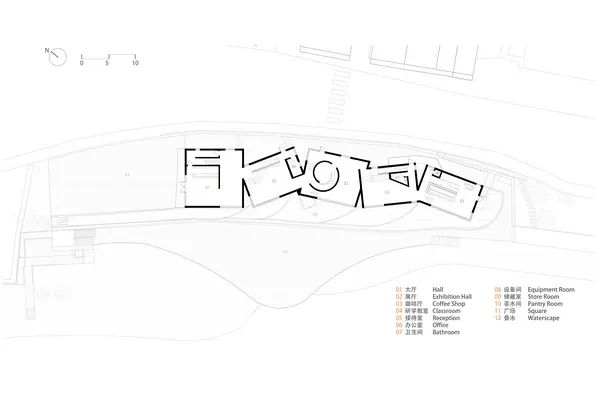泽雅龙溪艺术馆

下载所需积分: 5
泽雅被誉为温州“西雁荡”的省级风景名胜区。原名“寨下”,“泽雅”是温州方言中“寨下”的音译。泽雅拥有明清时期的传统建筑遗产;纸山文化 “国家级重点文物保护单位——四方纸坊” 被誉为“中国造纸活化石”,至今仍在山间活跃。
龙溪美术馆位于泽雅政府西侧的龙溪河景观带上。土地地块狭窄。东侧是通井路和文源路的交汇处,也是泽雅风景区的入口。当地的房屋、自营商店和流动小贩被保留下来,村民的日常活动使这个地区更加有生气。该项目预计以更新当地文化网络和邀请人们参与农村体验的态度面向城市,成为泽雅地标的乡村美术馆。因此,这个设计的重点是如何处理建筑与龙溪河、当地建筑以及当地人文之间的关系,以及探索城镇与乡村之间的关键关系。
该项目西面面向水景,东面面向主要道路。通过利用地块与景观步道之间的高差,地块地面向下挖2米,以减轻美术馆的压力,并与主要道路形成自然隔离。沿着趋势,建筑物沿着岸边分布着5个交错分散的体量,响应泽雅四方纸坊的传统建造文化。同时,场地南侧的开放空间用作入口广场,北侧的预留空间用作次要入口;在建筑物西侧引入当地重叠的水景和水岸平台,与原有的步行道连接;东侧利用建筑物与道路之间的空隙形成高差的乡间小路;通过场地和建筑物的三条路线为游客、当地居民和访客提供更大范围的活动,增强了漫游的乐趣。
从南到北依次下降的五个空间分别由接待区、展示区和咖啡区等功能区组成,并通过空间的重叠由台阶和坡道串联起来。接待区和最后的咖啡区的楼梯通往二楼,形成完整的闭合循环。建筑物的东西立面是开放自由的。在满足室内展示需求的前提下,保留了与居民视野和龙溪河景观的连接。
考虑到当地石材相对稀缺,混凝土已成为建筑主要材料。因此,建筑采用了现浇木制混凝土,既提高了结构的稳定性,又确保了空间的纯净性;同时;错位的碳化木模板赋予混凝土墙自然的木纹质感,增加了建筑与周围自然环境的亲和力。
美术馆作为城市文化发展的产物,当它被植入中国的乡村时,我们尝试将建筑与场地环境、地区文化和居民活动联系起来,削弱所谓的“非乡村化”的固有印象,以探索与乡村低干扰和强烈融合的关键关系。同时,我们尝试通过非常规的空间操作来响应美术馆的创新属性和它在农村排水方面的政治任务,寻求在当地地区实现新的乡村建筑表达和空间体验。
Zeya is known as a provincial-level scenic spot with the reputation of Wenzhou "West Yandang". The original name is "Zhaixia". Zeya is the transliteration of "Zhaixia" in Wenzhou dialect. Zeya is rich in heritage with the traditional buildings of Ming and Qing Dynasties ; The Paper Mountain Culture (the national key cultural relics protection unit-Quadruple Papermaking Workshop), known as the "living fossil of Chinese papermaking", is still active in the mountains.
The Longxi Art Museum is located on the Longxi River Landscape Belt on the west side of Zeya Government. The land plot is small and narrow. The east side is the intersection of Tongjing Road and Wenyuan Road, and it is also the gate of Zeya Scenic Area. The local houses, self-operated shops and mobile vendors are kept. The daily activities of the villagers makes this area more worldly . The project is expected to face the city with the attitude of renewing the local cultural network and inviting the people to participate in rural experience, and become a rural art gallery as Zeya's landmark. Therefore,the focus of this design is how to deal with the relationship between the building and Longxi River, local buildings, and local humanities, as well as exploring the critical relationship between towns and villages.
The project faces water landscape on the west and the major roads on the east. By using the height difference between the plot and the landscape trail, the plot ground was dug 2 meters underneath to dissolve the pressure of the art gallery and form a natural separation from the main road. Following the trend, the building fell down with 5 interlocking and scattered volumes along the shore, responding to the traditional construction culture of Zeya's Quadruple Papermaking Workshop. At the same time, the open space on the south side of site is used as the entrance plaza , and the reserved space on the north side is used as the secondary entrance; the local overlapping water landscape and waterside platform are introduced on the west side of the building to connect with the original walking trail; on the east side, the gap between building and roads is used to forms a country lane road with elevation difference; the three routes through the site and the building provides a larger range of activities for tourists, local residents, and visitors to enhance the fun of wandering.
The five spaces descending from the south to the north are successively composed of functional areas such as reception area, exhibition area, and coffee area, and are connected in series by steps and ramps in the overlap of the space. A staircase in the reception area and the last coffee area leads to the second floor, forming a complete closed circulation loop. The east and west facades of the building are open and free. On the premise of meeting the needs of indoor display, the connection between the residents' sight and the Longxi river landscape is preserved. Considering that the local stone is relatively scarce, and concrete has become the main material for the construction . Therefore, the building adopts cast-in-place wood-formed concrete, which improves the stability of the structure while ensuring the purity of the space; at the same time; The staggered carbonized wood formwork gives the concrete wall a natural wood grain texture, which increases the affinity of the building and responds to the surrounding natural environment.
Art gallery, as a product of urban cultural development,when it is implanted in Chinese villages,we try to link the building with the site environment, regional culture and residents' activities to weaken the inherent impression of the so-called "non-ruralization", so as to explore a critical relationship with low interference and strong integration with the countryside. At the same time, we try to respond to the innovative attributes of the art museum and its political mission to drain the countryside with unconventional spatial operations, seeking a new rural architectural expression and spatial experience in the local area.